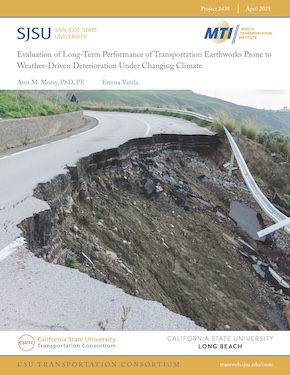- 408-924-7560
- mineta-institute@sjsu.edu
- Donate
Evaluation of Long-Term Performance of Transportation Earthworks Prone to Weather-Driven Deterioration Under Changing Climate
Embankments are key transportation infrastructure features providing essential support for long, linear stretches of transportation infrastructure, including highways and railways, in California and globally. Clay embankments are susceptible to weather-related deterioration processes that can gradually compromise their stability and, in some cases, lead to unexpected failures. Climate change, along with the associated shifts in weather patterns, is projected to adversely impact weather-related deterioration processes, leading to exacerbated failures and/or shorter service life. This study evaluated the impact of climate change on the rate of weather-driven deterioration of embankments in two locations in California: Los Angeles and Sacramento. Specifically, a multi-phase hydromechanical geotechnical model was developed for an exemplar clay embankment. The model is capable of simulating long-term performance of an embankment subject to a climate-controlled flux boundary. The model was used to perform numerical simulations where temperature and rainfall levels were adjusted to reflect four possible future climate change scenarios: Case (1) no average temperature or average precipitation changes; Case (2) +3℃ average temperature change and –12.5% average precipitation change; Case (3) +3℃average temperature change and no average precipitation change; and Case (4) +3℃ average temperature change and +12.5% average precipitation change. Performance indicators were obtained from the numerical simulations to compare the effect of climate change in Los Angeles and Sacramento. It was concluded that climate change is generally projected to adversely affect the long-term performance of clay embankments, which can put critical transportation infrastructure and the communities that depend on it at risk.
Amr M. Morsy, PhD, PE
Dr. Amr Morsy is a professional civil engineer with experience in both academia and industry. His research focuses on geotechnical engineering, transportation geotechnics, environmental geotechnics, and climate adaptation. He obtained his B.Eng and M.Sc. degrees in civil engineering from Cairo University in 2011 and 2013 respectively and obtained his PhD degree in civil engineering from The University of Texas at Austin in 2017. He worked as a postdoctoral fellow at The University of Texas at Austin in 2018 and as a practicing geotechnical engineer from 2018 to 2020. He later worked as a research associate at Loughborough University on the ACHILLES program grant from 2020 to 2022. He has been working as an assistant professor at California State University, Long Beach since 2022. As part of his academic experience, Dr. Morsy conducts research on geotechnical infrastructure deterioration and asset management, climate change impacts on geotechnical infrastructure, and geotechnical solutions for sustainable built environments. He has excelled in physical and numerical modeling of geotechnical and geoenvironmental engineering systems, and in infrastructure instrumentation and laboratory experimentation. He participated in research projects sponsored by the Transportation Research Board of the National Academies of Sciences, Engineering, and Medicine, the Engineering and Physical Sciences Research Council of the UK Research and Innovation, the US Federal Highway Administration, the Geosynthetic Institute, and the Departments of Transportation of Texas and Indiana. As part of his professional consulting experience, Dr. Morsy conducts rigorous analyses, designs, and forensic evaluations for a range of slopes, retaining walls, reinforced soil structures, deep excavations, bridge foundations, waste containment facilities, tailings dams, and embankment dams. He assisted expert witnesses in cases involving collapse and poor performance of earth retaining structures. He provided solutions to geotechnical problems in a number of environmental remediation projects involving cleanup of superfund sites. He conducted multi-phase flow analyses for several infrastructure features including earthworks, embankment dams, and cover systems. Some of the consulting projects he participated in served the US Environmental Protection Agency, New York State Department of Environmental Conservation, New York State and Indiana Departments of Transportation, Tennessee Valley Authority, New Jersey Transit, and several multinational private and public corporates.
Emma Varela
Emma Varela is a physics major in her junior year at California State University, Long Beach with a passion for the discipline and its interdisciplinary applications. Emma’s academic and research experiences have allowed her to explore the intersection of physics with other fields, such as engineering and climatology, while developing technical expertise and problem-solving skills. The research she is currently contributing to utilizes climate simulations to evaluate the deterioration of earthworks, with its ultimate aim being to develop innovative solutions with lasting impacts.
-
Contact Us
San José State University One Washington Square, San Jose, CA 95192 Phone: 408-924-7560 Email: mineta-institute@sjsu.edu






